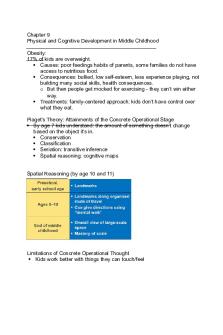Chapter 11: Physical Development in Middle Childhood PDF

| Title | Chapter 11: Physical Development in Middle Childhood |
|---|---|
| Author | Patricia Kiniry |
| Course | Child Development |
| Institution | Marist College |
| Pages | 3 |
| File Size | 108.5 KB |
| File Type | |
| Total Downloads | 83 |
| Total Views | 158 |
Summary
Professor Kristen Dovgan...
Description
11.11.19 Physical Development in Middle Childhood ages 6-12 Body Growth continues at a slow, regular pace girls: slightly shorter and lighter than boys until age 9, then trend reverses - girls tend to show the physical aspects of puberty before the cognitive ones catch up after age 8, girls accumulate fat at a faster rate Skeletal Growth bones lengthen ligaments not firmly attached to bones, unusual flexibility nighttime “growing pains” are common by 12, all baby teeth have been replaced by permanent teeth malocclusion: top and bottom jaw not properly lining up - ⅓ of school age children - common reason for braces Brain Development synaptic pruning: reorganization of neural connections - more effective information processing - prunes the transient exuberance that occurs in early childhood reaction time: time to respond to a stimulus, either physically or cognitively (with a thought) - improved by synaptic pruning - activities become second nature and require less thought Common Health Problems nutrition: - causes: - more focus on new friends and activities, less on eating - fewer meals with family - more freedom for bad diets: sugary drinks and fast food - buying lunch at school, trading with friends - poverty - feel better and focus better after eating healthy foods - prolonged malnutrition → permanent physical and mental impairments
11.11.19 overweight and obesity: - 32% of US children and adolescents are overweight - 17% obese - rise in overweight and obesity in many western nations - obesity rates have risen in developing countries - urbanization, globalization, and diet changes - cultural beliefs (overweight as a sign of prosperity) - obese children at risk for physical, emotional, and social problems - causes: - heredity, cultural food environment, socioeconomic status, availability of cheap fat and sugar, portion supersizing, early malnutrition, growth stunting, fast weight gain, family eating habits, food as a reward, overeating, responsiveness to food cues and hunger, lack of physical activity, increasingly busy lives, screen time (tv, phones) - stress prompts overeating - busier and more stressed now - elevated stress hormones signal brain to boost calorie intake - chronic stress triggers insulin resistance - managing chronic stress strains self-regulatory capacity, making it harder to limit excessive or poor eating - consequences: - social isolation → emotional, social, and school difficulties - unhappiness ↔ overeating - overweight girls reach puberty earlier which causes risks - poor mental health and well-being vision and hearing: - myopia (nearsighted): - most common vision problem in middle childhood - heredity, early trauma, increased eye strain - increases with higher SES - screen time - otitis media (middle ear infection): - more common in early childhood - may cause hearing loss after repeated infections bedwetting (nocturnal enuresis): - 1 in 10 kids - more boys than girls - biological roots - treated best with a urine alarm - punishment is not effective illnesses (book)
11.11.19 injuries (book) - injury fatalities increase from middle childhood into adolescence, with rates for boys rising considerably above those for girls - factors associated with dangerous environments and reduced parental monitoring of children— are also linked to high injury rates - motor vehicle accidents, involving children as passengers or pedestrians, continue to be the leading cause of injury, followed by bicycle accidents
Health Education for School-Age Kids food group plate - vegetables, grains, protein, fruits, and dairy - gap between knowledge and behavior still starting to teach mental health as an actual health issue Motor Development in Middle Childhood gains in gross-motor skills: - flexibility - balance - coordination - agility - force gains in fine-motor skills: - writing - handwriting is decreasing due to computer access - master uppercase letters, then lowercase - increased legibility - drawing - more organization, detail, and depth - copy two-dimensional shapes - relate objects to one another as part of organized whole - overlapping objects Pros and Cons of Physical Activity pros: - better overall health, less obesity, cooperation and fair play, problem-solving, respect for teammates and opponents of many ethnicities and nationalities cons: - low self-esteem, criticism, injuries, reinforces prejudices (especially other sex), increased stress...
Similar Free PDFs

Chapter 5 Middle Childhood
- 6 Pages

Middle Childhood
- 11 Pages
Popular Institutions
- Tinajero National High School - Annex
- Politeknik Caltex Riau
- Yokohama City University
- SGT University
- University of Al-Qadisiyah
- Divine Word College of Vigan
- Techniek College Rotterdam
- Universidade de Santiago
- Universiti Teknologi MARA Cawangan Johor Kampus Pasir Gudang
- Poltekkes Kemenkes Yogyakarta
- Baguio City National High School
- Colegio san marcos
- preparatoria uno
- Centro de Bachillerato Tecnológico Industrial y de Servicios No. 107
- Dalian Maritime University
- Quang Trung Secondary School
- Colegio Tecnológico en Informática
- Corporación Regional de Educación Superior
- Grupo CEDVA
- Dar Al Uloom University
- Centro de Estudios Preuniversitarios de la Universidad Nacional de Ingeniería
- 上智大学
- Aakash International School, Nuna Majara
- San Felipe Neri Catholic School
- Kang Chiao International School - New Taipei City
- Misamis Occidental National High School
- Institución Educativa Escuela Normal Juan Ladrilleros
- Kolehiyo ng Pantukan
- Batanes State College
- Instituto Continental
- Sekolah Menengah Kejuruan Kesehatan Kaltara (Tarakan)
- Colegio de La Inmaculada Concepcion - Cebu













